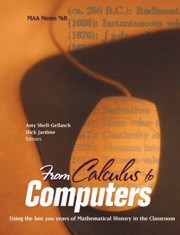Book contents
- Frontmatter
- Preface
- Contents
- Introduction
- I Algebra, Number Theory, Calculus, and Dynamical Systems
- II Geometry
- III Discrete Mathematics, Computer Science, Numerical Methods, Logic, and Statistics
- IV History of Mathematics and Pedagogy
- 16 Incorporating the Mathematical Achievements of Women and Minority Mathematicians into Classrooms
- 17 Mathematical Topics in an Undergraduate History of Science Course
- 18 Building a History of Mathematics Course from a Local Perspective
- 19 Protractors in the Classroom: An Historical Perspective
- 20 The Metric System Enters the American Classroom: 1790–1890
- 21 Some Wrinkles for a History of Mathematics Course
- 22 Teaching History of Mathematics Through Problems
- About the Authors
19 - Protractors in the Classroom: An Historical Perspective
from IV - History of Mathematics and Pedagogy
- Frontmatter
- Preface
- Contents
- Introduction
- I Algebra, Number Theory, Calculus, and Dynamical Systems
- II Geometry
- III Discrete Mathematics, Computer Science, Numerical Methods, Logic, and Statistics
- IV History of Mathematics and Pedagogy
- 16 Incorporating the Mathematical Achievements of Women and Minority Mathematicians into Classrooms
- 17 Mathematical Topics in an Undergraduate History of Science Course
- 18 Building a History of Mathematics Course from a Local Perspective
- 19 Protractors in the Classroom: An Historical Perspective
- 20 The Metric System Enters the American Classroom: 1790–1890
- 21 Some Wrinkles for a History of Mathematics Course
- 22 Teaching History of Mathematics Through Problems
- About the Authors
Summary
Introduction
The view of mathematics presented in the school supplies aisles of discount stores revolves around concrete aids: flash cards, rulers, protractors, graph paper, and the like. These inexpensive objects, although snapped up by the general public, are often completely foreign to the daily lives of contemporary mathematicians and mathematics educators. Meanwhile, parents, students, and teachers might assume their classroom tools have some sort of eternal existence outside of historical context. However, beneath surface appearances, there are links between mathematical teaching aids and professional mathematics. The history of mathematics can reveal such commonalties. For example, at the turn of the twentieth century, E. H. Moore required students to prepare graphs on squared paper, easing computation and revealing the ever-present relationship between abstract principles and concrete applications, when he advocated a “laboratory method” of teaching mathematics. [19] [33, pp. 318–319, 327] Yet, the connection between Moore, whose primary reputation was as a research mathematician, and the ubiquitous graph paper of today's elementary mathematics classroom is no longer recognized by many teachers and mathematicians. Similarly, the lowly protractor has a history that transcends abstract mathematics, applied sciences, and mathematical pedagogy and that deserves to be more widely known. Aspects of this story may assist those teachers who are trying to communicate mathematical ideas to students who may not have a background in abstract reasoning but who do have protractors wedged in their backpacks. Therefore, the purpose of this chapter is to provide an overview of the history of the protractor, incorporating suggestions for applying this story to classroom activities at a variety of academic levels.
- Type
- Chapter
- Information
- From Calculus to ComputersUsing the Last 200 Years of Mathematics History in the Classroom, pp. 217 - 228Publisher: Mathematical Association of AmericaPrint publication year: 2005

